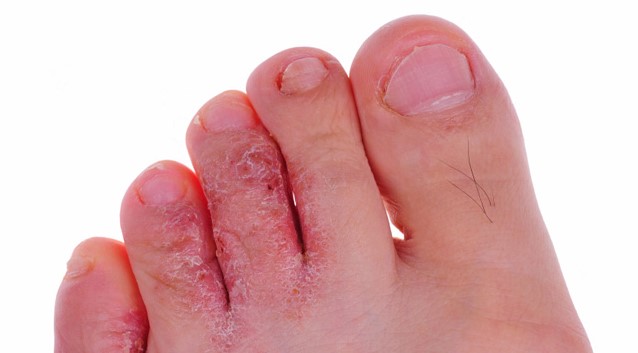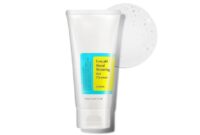Are you suffering from the uncomfortable and sometimes painful symptoms of athlete’s foot? This common fungal infection can be frustrating to deal with, but there are plenty of products on the market that can help. With so many choices, it can be overwhelming to decide which one is the best for your needs.
That’s why we’ve put together this guide to help you choose the best product for athlete’s foot.

First, let’s take a closer look at the symptoms and causes of athlete’s foot. This infection is caused by a fungus that thrives in warm, moist environments such as locker rooms, public showers, and swimming pools.
Symptoms can include itching, burning, and stinging between the toes, as well as redness, flaking, and cracking of the skin. Left untreated, athlete’s foot can spread to other areas of the foot or even to the hands.
But don’t worry, there are plenty of products that can help relieve these symptoms and get you back on your feet in no time.
Understanding Athlete’s Foot: Symptoms and Causes
If you’re feeling itchy, burning, and experiencing flaky skin on your feet, it could be a sign of athlete’s foot – a common fungal infection that can be frustrating to deal with.
Athlete’s foot is caused by a fungus that thrives in warm and moist environments, such as locker rooms, public showers, and swimming pools. The fungus can easily spread from person to person through direct contact with contaminated surfaces or objects.
To prevent athlete’s foot, it’s important to keep your feet clean and dry. Make sure to wash your feet with soap and water daily, and dry them thoroughly, especially between your toes. Wear breathable shoes and socks made of natural materials, such as cotton or wool.
Avoid sharing shoes or socks with others, and wear flip-flops or sandals in public showers or locker rooms. There are also many natural remedies that can help alleviate athlete’s foot symptoms, such as tea tree oil, vinegar, and garlic.
However, if your symptoms persist or worsen, it’s important to seek medical treatment.
Creams and Ointments: Pros and Cons
Creams and ointments are popular treatments for athlete’s foot because they provide quick relief from the itching and burning associated with foot fungus. However, they can also have some downsides.
For instance, some of these products may leave your skin feeling greasy and uncomfortable, like you’re wearing a pair of tight, sweaty socks all day. Additionally, some of these products may be expensive, which can be a problem if you’re on a tight budget.
When it comes to treating athlete’s foot with creams and ointments, you’ll need to weigh the effectiveness vs. affordability of each product. Some products may be more effective than others, but they may also come with a higher price tag.
Conversely, some more affordable products may not be as effective as their pricier counterparts. If you’re looking for a natural remedy, there are also some options available. For example, tea tree oil and garlic have been known to have antifungal properties and can be used to treat athlete’s foot.
Ultimately, it’s up to you to decide which treatment is best for you based on your individual needs and preferences.
[amazon box=”B0829DGWD5,B09PWXDPRD,B085KS85KX”]
Sprays and Powders: Which Ones Work Best?
Sprays and powders can be a game-changer in treating athlete’s foot. They’re convenient to use and provide a quick solution to combat the discomfort that comes with this fungal infection.
Sprays are particularly effective for treating athlete’s foot in between toes, as they can easily reach the affected area.
Powders, on the other hand, are great for keeping your feet dry and preventing the fungus from spreading.
When it comes to choosing the best spray or powder for athlete’s foot, there are plenty of options to choose from. Some products contain natural remedies such as tea tree oil, which can help soothe the irritation and inflammation caused by the infection.
Others may require a prescription from your doctor, as they contain stronger antifungal agents that can effectively eliminate the infection.
Whichever option you choose, it’s important to follow the instructions carefully and continue using the product for the recommended duration to ensure complete healing.
Soaks and Foot Baths: A Surprising Solution
Soaks and foot baths can be a refreshing oasis for your tired feet, washing away the discomfort of athlete’s foot like a cool stream in the desert. Two popular options for foot soaks are Epsom salt and vinegar.
Epsom salt foot soaks can help reduce inflammation and soothe itching, while vinegar foot soaks can help to kill the fungus that causes athlete’s foot. To make an Epsom salt foot soak, simply dissolve a cup of Epsom salt in warm water and soak your feet for 10-15 minutes. For a vinegar foot soak, mix equal parts water and white vinegar in a basin and soak your feet for 10-15 minutes.
Another popular option for foot baths is adding tea tree oil or baking soda to the water. Tea tree oil has antifungal and antibacterial properties that can help fight off the fungus that causes athlete’s foot. Baking soda can help to neutralize odors and soothe itching.
To make a tea tree oil foot bath, add a few drops of tea tree oil to warm water and soak your feet for 10-15 minutes. For a baking soda foot bath, add a quarter cup of baking soda to warm water and soak your feet for 10-15 minutes.
These foot baths can be a great addition to your athlete’s foot treatment regimen and provide a relaxing way to pamper your feet.
Choosing the Right Product for Your Needs
When it comes to finding the best product for athlete’s foot, it’s crucial to consider the unique needs of your individual situation. This means taking into account the severity of your condition, any allergies you might have, and your personal preferences when it comes to treatment.
One key factor to consider is ingredient effectiveness. Look for products that contain antifungal ingredients like terbinafine, clotrimazole, or miconazole. These compounds work by targeting the root cause of athlete’s foot and eliminating the fungal infection that causes itching, burning, and discomfort.
Another important consideration when choosing a product for athlete’s foot is brand comparison. Different brands offer different formulations, concentrations, and delivery methods, so it’s important to do your research and read product reviews before making a purchase. Some brands might offer more powerful antifungal agents, while others might have gentler formulas that are better suited for sensitive skin.
Ultimately, the right product for you will depend on a variety of factors, including your preferences, the severity of your condition, and the specific type of athlete’s foot you’re dealing with. By taking the time to compare different brands and ingredients, you can find a product that effectively treats your symptoms and helps you get back on your feet.
Frequently Asked Questions
Are there any natural remedies for athlete’s foot?
Are you tired of dealing with the itching and burning of athlete’s foot? Luckily, there are natural remedies that can help ease your discomfort.
Herbal remedies, like tea tree oil and garlic, have been shown to have antifungal properties and can be effective in treating athlete’s foot. Essential oils, like lavender and peppermint, can also be beneficial in reducing inflammation and providing relief.
So, before you reach for a harsh chemical treatment, consider trying one of these natural options to soothe your symptoms. Remember, your feet carry you through life, so treat them with the care they deserve.
How long does it typically take for athlete’s foot to heal with treatment?
When it comes to treating athlete’s foot, the healing duration can vary depending on the severity of the infection and the type of treatment you use. Generally, with proper treatment, symptoms can start to improve within a few days to a week.
Over-the-counter antifungal creams and sprays are usually effective in treating mild cases of athlete’s foot. However, if the infection is more severe, you may need prescription-strength medication.
It’s important to continue using the treatment for the recommended length of time, even if your symptoms start to improve. This will help ensure that the infection is fully cleared and reduce the risk of it coming back.
Overall, with the right treatment, athlete’s foot can be effectively treated in a matter of weeks.
Can athlete’s foot be prevented?
Preventing athlete’s foot is essential if you want to avoid the discomfort of this pesky fungus. And let’s be real, nobody wants to deal with that. So, how can you prevent it?
It’s simple – practice good hygiene! Wash your feet daily with soap and water, dry them thoroughly, and wear clean socks and shoes. If you like to walk barefoot in public places, it’s time to kick that habit to the curb.
Keeping your feet covered in communal areas like locker rooms or public showers is a great way to reduce your risk of getting athlete’s foot. By taking these preventative measures, you’ll be able to keep your feet fungus-free and avoid the hassle of dealing with athlete’s foot altogether.
Is athlete’s foot contagious and how can it be transmitted to others?
Did you know that athlete’s foot is highly contagious and can be easily transmitted to others?
There are several transmission factors to be aware of, including walking barefoot in public places, sharing shoes or socks, and having close contact with someone who has the infection.
However, there are prevention measures you can take to avoid getting infected or spreading it to others. These include keeping your feet clean and dry, wearing clean and breathable shoes and socks, avoiding walking barefoot in public areas, and using antifungal powders or sprays if you’re prone to this infection.
By following these simple steps, you can keep athlete’s foot at bay and enjoy healthy and happy feet.
Are there any potential side effects of using athlete’s foot treatments?
When it comes to treating athlete’s foot, there are several options to consider. However, it’s important to be aware of the potential side effects and safety concerns associated with these treatments.
Before selecting a product, it’s recommended that you conduct an efficacy analysis and consider alternative options. Additionally, it’s important to consider the long term outcomes and any clinical studies that have been conducted. Expert recommendations and user experiences can also provide valuable insight.
Finally, a cost benefit analysis can help you determine the most practical and effective treatment. Common misconceptions about athlete’s foot and its treatment should also be addressed.
By taking these factors into consideration, you can make an informed decision about the best product for your individual needs.
Conclusion
Now that you have a better understanding of athlete’s foot, it’s time to choose the right product to treat it.
While creams and ointments can be effective, they may not be the best option for those with particularly sweaty feet. Sprays and powders may be more suitable, but it’s important to choose ones that contain antifungal ingredients.
Don’t overlook the power of soaks and foot baths, which can help soothe and heal your feet while also fighting off the infection. Ultimately, the best product for athlete’s foot will depend on your individual needs and preferences.
Don’t be afraid to try a few different options until you find the one that works best for you. With the right product and a little bit of patience, you can say goodbye to athlete’s foot and get back to doing what you love.


